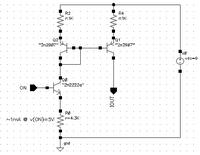unseen wombat
Newbie level 4
Hey guys, I know this is probably a really simple question, but I want to limit the current of my circuit's output to ~1mA, but not the voltage and I don't know how.
Let me explain what I'm doing. I'm building a Cranial Electrical Stimulation (CES) device, using an Atmel microcontroller, to use for lucid dreaming. I'm okay with the programming portion of it, and it's just handling the output that I need help with.
Here is a schematic of my design:
**broken link removed**
What it does is this: pins 2 and 7 of the IC just output square waves at a certain frequency. When 2 is high, 7 is low and vice versa. The two transistors directly left and right of the IC then amplify the 5V output to the battery's full 9 volts and leads from their emitters are attached to opposite ears. The other two transistors are there to short the other ear to ground and direct the 1 mA current through the person's head. So, for example, if pin 7 were high, pin 2 would be low. The red lead in the schematic going to the left ear would send 9 volts, the green lead coming from the right ear would short to ground and complete the circuit. The green lead attached to the left ear is shut off, because pin 2 is low, preventing a short circuit right at the left ear. Does my logic make sense?
Anyway, I thought I would just need a resistor attached to the collectors of the output transistors to limit the current to 1mA and the voltage would still be 9V, but as I'm sure you all know, that didn't work. I got about .03 V and up to 50 mA depending on the size of the resistor. So what do I need to do to get 1mA at 9V? Do I need a capacitor in there somewhere? Oh, the transistors are NPN 2N2222's and the battery is a 9V alkaline if it makes any difference.
Thanks for your help.
Let me explain what I'm doing. I'm building a Cranial Electrical Stimulation (CES) device, using an Atmel microcontroller, to use for lucid dreaming. I'm okay with the programming portion of it, and it's just handling the output that I need help with.
Here is a schematic of my design:
**broken link removed**
What it does is this: pins 2 and 7 of the IC just output square waves at a certain frequency. When 2 is high, 7 is low and vice versa. The two transistors directly left and right of the IC then amplify the 5V output to the battery's full 9 volts and leads from their emitters are attached to opposite ears. The other two transistors are there to short the other ear to ground and direct the 1 mA current through the person's head. So, for example, if pin 7 were high, pin 2 would be low. The red lead in the schematic going to the left ear would send 9 volts, the green lead coming from the right ear would short to ground and complete the circuit. The green lead attached to the left ear is shut off, because pin 2 is low, preventing a short circuit right at the left ear. Does my logic make sense?
Anyway, I thought I would just need a resistor attached to the collectors of the output transistors to limit the current to 1mA and the voltage would still be 9V, but as I'm sure you all know, that didn't work. I got about .03 V and up to 50 mA depending on the size of the resistor. So what do I need to do to get 1mA at 9V? Do I need a capacitor in there somewhere? Oh, the transistors are NPN 2N2222's and the battery is a 9V alkaline if it makes any difference.
Thanks for your help.
